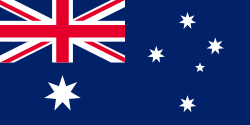Tarcoola
| Tarcoola | |||||
|---|---|---|---|---|---|
| |||||
| |||||
| |||||
| |||||
Tarcoola ist eine etwa 740 km nordwestlich von Adelaide gelegene Siedlung in Südaustralien. Tarcoola wurde am 21. Februar 1901 gegründet und nach der nahegelegenen Tarcoola-Goldmine benannt, die ihren Namen wiederum von einem Rennpferd erhalten hat, das 1893 das Melbourne-Cup-Pferderennen gewonnen hatte. In der Ortschaft lebt heutzutage niemand mehr (Stand: 2016).[1]
Tarcoola ist hauptsächlich als Verzweigungspunkt der beiden längsten australischen Eisenbahnstrecken, der Transaustralische Eisenbahn von Perth nach Port Augusta (und weiter nach Sydney) und der Zentralaustralischen Eisenbahn von Darwin nach Tarcoola (und weiter nach Adelaide) bekannt. Der Bahnhof liegt in einem Gleisdreieck, das es jedem Zug ermöglicht, in jede der beiden anderen möglichen Richtungen weiter zu fahren, ohne die Fahrtrichtung ändern zu müssen. Ein zweites Gleisdreieck im Bahnhof ermöglicht es, Fahrzeuge zu wenden.
Klima
| Tarcoola Flughafen | ||||||||||||||||||||||||||||||||||||||||||||||||
|---|---|---|---|---|---|---|---|---|---|---|---|---|---|---|---|---|---|---|---|---|---|---|---|---|---|---|---|---|---|---|---|---|---|---|---|---|---|---|---|---|---|---|---|---|---|---|---|---|
| Klimadiagramm | ||||||||||||||||||||||||||||||||||||||||||||||||
| ||||||||||||||||||||||||||||||||||||||||||||||||
Monatliche Durchschnittstemperaturen und -niederschläge für Tarcoola Flughafen
Quelle: Bureau of Meteorology | |||||||||||||||||||||||||||||||||||||||||||||||||||||||||||||||||||||||||||||||||||||||||||||||||||||
Bildergalerie
- Tarcoola (frühe 1920er-Jahre)
- Tarcoola (frühe 1920er-Jahre)
- Tarcoola (1934)
- Tarcoola (1963)
- Tarcoola (1963)
- Tarcoola (2009)
Quellen
- ↑ a b Tarcoola. 2016 Census Quickstat. Australian Bureau of Statistics, 27. Juni 2017, abgerufen am 29. April 2020 (englisch).
Auf dieser Seite verwendete Medien
Flag of Australia, when congruence with this colour chart is required (i.e. when a "less bright" version is needed).
See Flag of Australia.svg for main file information.Workers' houses at Tarcoola, South Australia, on the Trans-Australian Railway. They were tents, with a raised floor, lined with plywood and with a corrugated iron roof overhead.
Autor/Urheber: NordNordWest, Lizenz: CC BY-SA 3.0 de
Positionskarte von South Australia, Australien
Provisions store at Tarcoola, South Australia, for Commonwealth Railways employees on the Trans-Australian Railway
Elevated view of the railway yard at Tarcoola, South Australia, on the Trans-Australian Railway
Autor/Urheber: Lindsay Bridge.
When re-used, attribute as:
Photographer and copyright owner: Lindsay Bridge. CC BY 2.0., Lizenz: CC BY 2.0
Tarcoola station, South Australia, on the Trans-Australian Railway, seen from the "Tea and Sugar" weekly supply train for railway employees and their families.
"Iron Man" monument to commemorate the millionth concrete sleeper (US: crosstie) laid on the Tarcoola-Alice Springs segment of the Adelaide-Darwin railway line.
Autor/Urheber: Lindsay Bridge.
When re-used, attribute as:
Photographer and copyright owner: Lindsay Bridge. CC BY 2.0., Lizenz: CC BY 2.5
A view of Tarcoola railway station and employee houses, South Australia, on the Trans-Australian Railway in 1963. At that time Tarcoola was a railway station at which trains stopped, and some facilities for steam locomotives (which had not operated since the early 1950s) and diesel locomotives are visible. Since 2004 it has been the junction of the Trans-Australian Railway and the Adelaide–Darwin railway; since 2014 nobody has lived there permanently.
Flag of South Australia, from the xrmap flag collection 2.9. Modifications by Denelson83.














